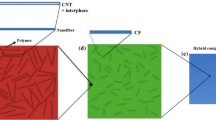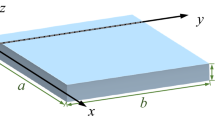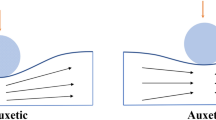Abstract
In this paper, the low velocity impact analysis of carbon nanotube (CNT)/carbon fiber (CF)-reinforced hybrid nanocomposite plates is presented using variational differential quadrature (VDQ) method due to its numerical essence and the framework of implementation. The hybrid nanocomposite plate deformation is formulated based on classical plate theory and the contact force between the plate and projectile is estimated using Hertzian contact law. Also, a new micromechanics approach is presented to calculate the effective mechanical properties of the CNT/CF polymer hybrid nanocomposites. Five important factors including, random orientation and random distribution of CNTs, CNT/polymer interphase region, waviness and transversely isotropic behavior of CNT are incorporated in the micromechanical analysis. The accuracy of the present approach is verified with the available open literature results showing a clear agreement. The effects of various factors such as volume fraction and non-straight shape of CNT, CNT/polymer interphase region, CF volume fraction, random and regular arrangement of CFs, plate geometrical parameters and impactor velocity on the low velocity impact behavior of the CNT/CF-reinforced hybrid nanocomposite plates are studied.
















Similar content being viewed by others
References
Iijima S (1991) Helical microtubules of graphitic carbon. Nature 354(6348):56
Ginga NJ, Chen W, Sitaraman SK (2014) Waviness reduces effective modulus of carbon nanotube forests by several orders of magnitude. Carbon 66:57–66
Shirasu K, Nakamura A, Yamamoto G, Ogasawara T, Shimamura Y, Inoue Y, Hashida T (2017) Potential use of CNTs for production of zero thermal expansion coefficient composite materials: An experimental evaluation of axial thermal expansion coefficient of CNTs using a combination of thermal expansion and uniaxial tensile tests. Compos A Appl Sci Manuf 95:152–160
Ghassabi M, Zarastvand MR, Talebitooti R (2019) Investigation of state vector computational solution on modeling of wave propagation through functionally graded nanocomposite doubly curved thick structures. Eng Comput. https://doi.org/10.1007/s00366-019-00773-6
Hassanzadeh-Aghdam MK, Mahmoodi MJ, Ansari R (2019) Creep performance of CNT polymer nanocomposites-An emphasis on viscoelastic interphase and CNT agglomeration. Compos B Eng 168:274–281
Hassanzadeh-Aghdam MK, Mahmoodi MJ, Jamali J, Ansari R (2019) A new micromechanical method for the analysis of thermal conductivities of unidirectional fiber/CNT-reinforced polymer hybrid nanocomposites. Compos B Eng 175:107137
Hajmohammad MH, Nouri AH, Zarei MS, Kolahchi R (2018) A new numerical approach and visco-refined zigzag theory for blast analysis of auxetic honeycomb plates integrated by multiphase nanocomposite facesheets in hygrothermal environment. Eng Comput 1:1–17
Ahmadi M, Ansari R, Rouhi H (2017) Multi-scale bending, buckling and vibration analyses of carbon fiber/carbon nanotube-reinforced polymer nanocomposite plates with various shapes. Phys E 93:17–25
Li K, Gao XL, Roy AK (2006) Micromechanical modeling of viscoelastic properties of carbon nanotube-reinforced polymer composites. Mech Adv Mater Struct 13(4):317–328
Schadler LS, Giannaris SC, Ajayan PM (1998) Load transfer in carbon nanotube epoxy composites. Appl Phys Lett 73(26):3842–3844
Qian D, Dickey EC, Andrews R, Rantell T (2000) Load transfer and deformation mechanisms in carbon nanotube-polystyrene composites. Appl Phys Lett 76(20):2868–2870
Rong C, Ma G, Zhang S, Song L, Chen Z, Wang G, Ajayan PM (2010) Effect of carbon nanotubes on the mechanical properties and crystallization behavior of poly (ether ether ketone). Compos Sci Technol 70(2):380–386
Montazeri A, Javadpour J, Khavandi A, Tcharkhtchi A, Mohajeri A (2010) Mechanical properties of multi-walled carbon nanotube/epoxy composites. Mater Des 31(9):4202–4208
Watters A, Cuadra J, Kontsos A, Palmese G (2015) Processing-structure–property relationships of SWNT–epoxy composites prepared using ionic liquids. Compos A Appl Sci Manuf 73:269–276
Ansari R, Hassanzadeh-Aghdam MK (2016) Micromechanical investigation of creep-recovery behavior of carbon nanotube-reinforced polymer nanocomposites. Int J Mech Sci 115:45–55
Zhang J, He C (2008) A three-phase cylindrical shear-lag model for carbon nanotube composites. Acta Mech 196(1–2):33–54
Dastgerdi JN, Marquis G, Salimi M (2013) The effect of nanotubes waviness on mechanical properties of CNT/SMP composites. Compos Sci Technol 86:164–169
Alva A, Bhagat A, Raja S (2015) Effective moduli evaluation of carbon nanotube reinforced polymers using micromechanics. Mech Adv Mater Struct 22(10):819–828
Kundalwal SI, Meguid SA (2015) Effect of carbon nanotube waviness on active damping of laminated hybrid composite shells. Acta Mech 226(6):2035–2052
Ansari R, Hassanzadeh-Aghdam MK (2017) Micromechanical characterizing elastic, thermoelastic and viscoelastic properties of functionally graded carbon nanotube reinforced polymer nanocomposites. Meccanica 52(7):1625–1640
Topac OT, Gozluklu B, Gurses E, Coker D (2017) Experimental and computational study of the damage process in CFRP composite beams under low-velocity impact. Compos A Appl Sci Manuf 92:167–182
Bonhomme J, Viña J, Argüelles A, Viña I, Mollón V (2013) Influence of the matrix toughness in carbon-epoxy composites subjected to delamination under modes I, II, and mixed I/II. Mech Adv Mater Struct 20(8):679–686
Malakooti MH, Sodano HA (2013) Multi-inclusion modeling of multiphase piezoelectric composites. Compos B Eng 47:181–189
Hassanzadeh-Aghdam MK, Ansari R (2018) Thermomechanical investigation of unidirectional carbon fiber-polymer hybrid composites containing CNTs. Int J Mech Mater Des 1:1–18
Beicha D, Kanit T, Brunet Y, Imad A, El Moumen A, Khelfaoui Y (2016) Effective transverse elastic properties of unidirectional fiber reinforced composites. Mech Mater 102:47–53
Liu YJ, Xu N, Luo JF (2000) Modeling of interphases in fiber-reinforced composites under transverse loading using the boundary element method. J Appl Mech 67(1):41–49
Aldajah S, Haik Y (2012) Transverse strength enhancement of carbon fiber reinforced polymer composites by means of magnetically aligned carbon nanotubes. Mater Des 34:379–383
Li Q, Church JS, Naebe M, Fox BL (2016) A systematic investigation into a novel method for preparing carbon fibre–carbon nanotube hybrid structures. Compos A Appl Sci Manuf 90:174–185
Eslami Z, Yazdani F, Mirzapour MA (2015) Thermal and mechanical properties of phenolic-based composites reinforced by carbon fibres and multiwall carbon nanotubes. Compos A Appl Sci Manuf 72:22–31
An F, Lu C, Li Y, Guo J, Lu X, Lu H, Yang Y (2012) Preparation and characterization of carbon nanotube-hybridized carbon fiber to reinforce epoxy composite. Mater Des 33:197–202
Wang S, Qiu J (2010) Enhancing thermal conductivity of glass fiber/polymer composites through carbon nanotubes incorporation. Compos B Eng 41(7):533–536
Li J, Zhang LQ (2009) The addition of carbon nanotube on the tensile properties of carbon fiber-reinforced PEEK composites. Polym Plast Technol Eng 48(11):1176–1179
Pal G, Kumar S (2016) Multiscale modeling of effective electrical conductivity of short carbon fiber-carbon nanotube-polymer matrix hybrid composites. Mater Des 89:129–136
Kim YA, Kamio S, Tajiri T, Hayashi T, Song SM, Endo M, Dresselhaus MS (2007) Enhanced thermal conductivity of carbon fiber/phenolic resin composites by the introduction of carbon nanotubes. Appl Phys Lett 90(9):093125
Kim MT, Rhee KY, Lee JH, Hui D, Lau AK (2011) Property enhancement of a carbon fiber/epoxy composite by using carbon nanotubes. Compos B Eng 42(5):1257–1261
Sánchez M, Campo M, Jiménez-Suárez A, Ureña A (2013) Effect of the carbon nanotube functionalization on flexural properties of multiscale carbon fiber/epoxy composites manufactured by VARIM. Compos B Eng 45(1):1613–1619
Shokrieh MM, Daneshvar A, Akbari S (2014) Reduction of thermal residual stresses of laminated polymer composites by addition of carbon nanotubes. Mater Des 53:209–216
Ahmadi M, Ansari R, Rouhi H (2017) Multi-scale bending, buckling and vibration analyses of carbon fiber/carbon nanotube-reinforced polymer nanocomposite plates with various shapes. Physica E 93:17–25
Liew KM, Lei ZX, Zhang LW (2015) Mechanical analysis of functionally graded carbon nanotube reinforced composites: a review. Compos Struct 120:90–97
Karsli NG, Yesil S, Aytac A (2014) Effect of hybrid carbon nanotube/short glass fiber reinforcement on the properties of polypropylene composites. Compos B Eng 63:154–160
Ma X, Scarpa F, Peng HX, Allegri G, Yuan J, Ciobanu R (2015) Design of a hybrid carbon fibre/carbon nanotube composite for enhanced lightning strike resistance. Aerosp Sci Technol 47:367–377
Khalili SMR, Malekzadeh K, Gorgabad AV (2013) Low velocity transverse impact response of functionally graded plates with temperature dependent properties. Compos Struct 96:64–74
Setoodeh A, Malekzadeh P, Nikbin K (2009) Low velocity impact analysis of laminated composite plates using a 3D elasticity based layerwise FEM. Mater Des 30(9):3795–3801
Christoforou AP, Yigit AS (2009) Scaling of low-velocity impact response in composite structures. Compos Struct 91(3):358–365
Wang Z, Xu J, Qiao P (2014) Nonlinear low-velocity impact analysis of temperature dependent nanotube-reinforced composite plates. Compos Struct 108:423–434
Malekzadeh P, Dehbozorgi M (2016) Low velocity impact analysis of functionally graded carbon nanotubes reinforced composite skew plates. Compos Struct 140:728–748
Selim BA, Zhang LW, Liew KM (2017) Impact analysis of CNT-reinforced composite plates based on Reddy’s higher-order shear deformation theory using an element-free approach. Compos Struct 170:228–242
Yang CH, Ma WN, Ma DW (2018) Low-velocity impact analysis of carbon nanotube reinforced composite laminates. J Mater Sci 53(1):637–656
Babuška I, Suri M (1992) On locking and robustness in the finite element method. SIAM J Num Anal 29(5):1261–1293
Shojaei MF, Ansari R (2017) Variational differential quadrature: a technique to simplify numerical analysis of structures. Appl Math Model 49:705–738
Hasrati E, Ansari R, Rouhi H (2019) Elastoplastic postbuckling analysis of moderately thick rectangular plates using the variational differential quadrature method. Aerosp Sci Technol 91:479–493
Hassanzadeh-Aghdam MK, Ansari R, Darvizeh A (2017) Micromechanical modeling of thermal expansion coefficients for unidirectional glass fiber-reinforced polyimide composites containing silica nanoparticles. Compos A 96:110–121
Kundalwal SI, Ray MC (2012) Effective properties of a novel continuous fuzzy-fiber reinforced composite using the method of cells and the finite element method. Eur J Mech A Solids 36:191–203
Kundalwal SI, Ray MC (2014) Effect of carbon nanotube waviness on the effective thermoelastic properties of a novel continuous fuzzy fiber reinforced composite. Compos B Eng 57:199–209
Seidel GD, Lagoudas DC (2006) Micromechanical analysis of the effective elastic properties of carbon nanotube reinforced composites. Mech Mater 38(8):884–907
Tsai JL, Tzeng SH, Chiu YT (2010) Characterizing elastic properties of carbon nanotubes/polyimide nanocomposites using multi-scale simulation. Compos B Eng 41(1):106–115
Jasiuk I, Kouider MW (1993) The effect of an inhomogeneous interphase on the elastic constants of transversely isotropic composites. Mech Mater 15:53–63
Chouchaoui CS, Benzeggagh ML (1997) The effect of interphase on the elastic behavior of a glass/epoxy bundle. Compos Sci Technol 57:617–622
Boutaleb S, Zairi F, Mesbah A, Nait-Abdelaziz M, Gloague JM, Boukharouba T, Lefebvre JM (2009) Micromechanics-based modelling of stiffness and yield stress for silica/polymer nanocomposites. Int J Solids Struct 46:1716–1726
Zare Y (2015) Effects of interphase on tensile strength of polymer/CNT nanocomposites by Kelly–Tyson theory. Mech Mater 85:1–6
Yanase K, Moriyama S, Ju JW (2013) Effects of CNT waviness on the effective elastic responses of CNT-reinforced polymer composites. Acta Mech 224(7):1351–1364
Qu J, Cherkaoui M (2006) Fundamentals of micromechanics of solids. Wiley, New Jersey
Abrate S (ed) (2011) Impact engineering of composite structures, vol 526. Springer, Berlin
Shojaei MF, Ansari R (2017) Variational differential quadrature: a technique to simplify numerical analysis of structures. Appl Math Model 49:705–738
Gholami R, Ansari R (2018) Nonlinear harmonically excited vibration of third-order shear deformable functionally graded graphene platelet-reinforced composite rectangular plates. Eng Struct 156:197–209
Ansari R, Torabi J, Shojaei MF (2017) Buckling and vibration analysis of embedded functionally graded carbon nanotube-reinforced composite annular sector plates under thermal loading. Compos B Eng 109:197–213
Honjo K (2007) Thermal stresses and effective properties calculated for fiber composites using actual cylindrically-anisotropic properties of interfacial carbon coating. Carbon 45(4):865–872
Miyagawa H, Mase T, Sato C, Drown E, Drzal LT, Ikegami K (2006) Comparison of experimental and theoretical transverse elastic modulus of carbon fibers. Carbon 44(10):2002–2008
Pan Y, Weng GJ, Meguid SA, Bao WS, Zhu ZH, Hamouda AMS (2013) Interface effects on the viscoelastic characteristics of carbon nanotube polymer matrix composites. Mech Mater 58:1–11
Fisher FT, Bradshaw RD, Brinson LC (2003) Fiber waviness in nanotube-reinforced polymer composites-I: modulus predictions using effective nanotube properties. Compos Sci Technol 63(11):1689–1703
Tian L, Li L (2018) A review on the strengthening of nanostructured materials. Int J Curr Eng Technol 8:2
Hassanzadeh-Aghdam MK, Ansari R, Mahmoodi MJ (2018) Thermal expanding behavior of carbon nanotube-reinforced metal matrix nanocomposites—a micromechanical modeling. J Alloy Compd 744:637–650
Hassanzadeh-Aghdam MK, Mahmoodi MJ, Safi M (2019) Effect of adding carbon nanotubes on the thermal conductivity of steel fiber-reinforced concrete. Compos Part B Eng 1:106972
Funding
The author(s) received no financial support for the research, authorship, and/or publication of this article.
Author information
Authors and Affiliations
Corresponding authors
Ethics declarations
Conflict of interest
The author(s) declared no potential conflicts of interest with respect to the research, authorship, and/or publication of this article.
Additional information
Publisher's Note
Springer Nature remains neutral with regard to jurisdictional claims in published maps and institutional affiliations.
Rights and permissions
About this article
Cite this article
Oskouie, M.F., Hassanzadeh-Aghdam, M.K. & Ansari, R. A new numerical approach for low velocity impact response of multiscale-reinforced nanocomposite plates. Engineering with Computers 37, 713–730 (2021). https://doi.org/10.1007/s00366-019-00851-9
Received:
Accepted:
Published:
Issue Date:
DOI: https://doi.org/10.1007/s00366-019-00851-9




